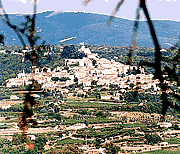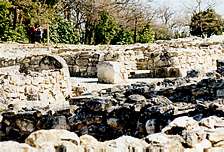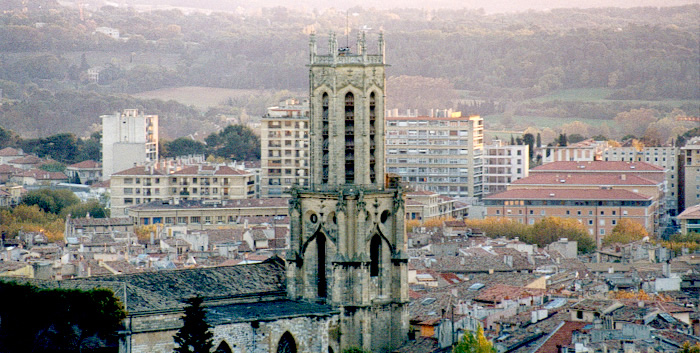|
|
|
|
| |
| Architecture in Aix-en-Provence |
|
|
|
| |
 |
|
 Architecture
bears the stamp of its orgins expressing the spirit and matter prevailing
at the time of its creation. From the primitive stone igloo shaped
shelters, bories, of the Vaucluse to Le Corbusier’s "machine
for living" in Marseille and the "barres" that
circle the city to the north of Aix, a succession of styles, of intention
and accident, tell the story of Provence’s encounter, sometimes
clash, between man and nature. Superhighways split elegant domains
in two, the T.G.V. railroads its path through vineyard and meadow,
and the rubble of venerable ramparts lies beneath low-cost, high-rise
apartments, alien both to the countryside that surrounds them and
the towns within. Architecture
bears the stamp of its orgins expressing the spirit and matter prevailing
at the time of its creation. From the primitive stone igloo shaped
shelters, bories, of the Vaucluse to Le Corbusier’s "machine
for living" in Marseille and the "barres" that
circle the city to the north of Aix, a succession of styles, of intention
and accident, tell the story of Provence’s encounter, sometimes
clash, between man and nature. Superhighways split elegant domains
in two, the T.G.V. railroads its path through vineyard and meadow,
and the rubble of venerable ramparts lies beneath low-cost, high-rise
apartments, alien both to the countryside that surrounds them and
the towns within.
|
| |
Visitors
come, however, not to bewail the conflict, but to celebrate the truce
between man and nature, landscape and manscape. They may deplore misbegotten
creations of the twentieth century, and ponder their familiar ugliness,
the dereliction of our age, but, mercifully, the beauty of Provençal
streets, squares, fountains, and perched villages, transcends time.
Village, town, and city still cluster around church, town square, and
château-town-hall, and many have preserved their stout walls
that attract more visitors than they ever discouraged invaders. |
| |
The "pays
d’Aix" alone offers a rich sampling of architecture
dating from its pre-Roman foundation on the hill to the north
now known as Entremont. Springs, some thermal, emerge
at the natural crossroads below known to shepherds, merchants,
and travellers on their way north, south, east, and west
from time immemorial. Celto-Ligurian military and civil architecture
dating from the fourth century B.C. still crowns the hill,
its ramparts still stand, and its streets, dwellings and
public places have been excavated and restored over the past
fifty years. |
|
 |
|
| |
The
conscientious thoroughness with which the Romans applied their recipe
for "peace through deletion" has left intact and visible
more of Entremont today than have the generations that have succeeded
the thriving Roman castrum and colonia on whose site Aix now stands. Entremont’s
Salluvian town planning, sculpture, olive presses, and military fortifications
are now distributed unequally between the Musée Granet and the
site, with its vast area still "undug" intra muros. Arles,
Nîmes, le Pont du Gard, Glanum, Orange, Vaison-la-Romaine, are
the most celebrated of Provence’s "Roman" cities. Less
ostentatious though perhaps more evocative are stretches of Roman road
that remain with, here and there lost in the countryside, the empty
shell of Roman temples whose stones have served and served again to
build the
walls of neighbouring houses, farms, and châteaux. Our present
concern, however is with Aix-en-Provence, ancient archbishopric and
capital. |
| |
 |
| |
Neglect
and abandonment are probably less responsible for the disappearance
of Roman monuments and historic buildings than periodic prosperity
that
spurs present ambition and knows no scruples in exploiting elements
that have been quarried from an earlier age. Aix’s Middle Ages,
like its Gallo-Roman era, lie safely embedded in its walls. The cathedral
baptistry, for example, happily combines fifth century foundations
with
columns "borrowed" from a Roman temple or basilica, and a
sixteenth century cupola.
The cathedral itself,
with its west wall of Roman "pierre taillée",
its twelfth century cloister, Romanesque portal, and Romanesque nave
nestling against its junior, taller, and less lovely Gothic cousin,
stand in uneasy imbalance with the opposing nave of Notre-Dame
d’Espérance,
to the north. Contemporary with the central nave, but combining baroque,
neoclassic, and mediaeval architecture in bewildering propinquity,
this nave is a jewel for the student of art history, a nightmare
for the purist. Had a seventeenth century architect had his way,
it is
assumed that he would have "improved" the romanesque construction
of the other, southern flank thus achieving symmetry at the cost
of one of the cathedral’s most lovely attributes. |
| |
|
| |
|
| |



